The Last Supper - A Study of the Painting by Leonardo Da Vinci
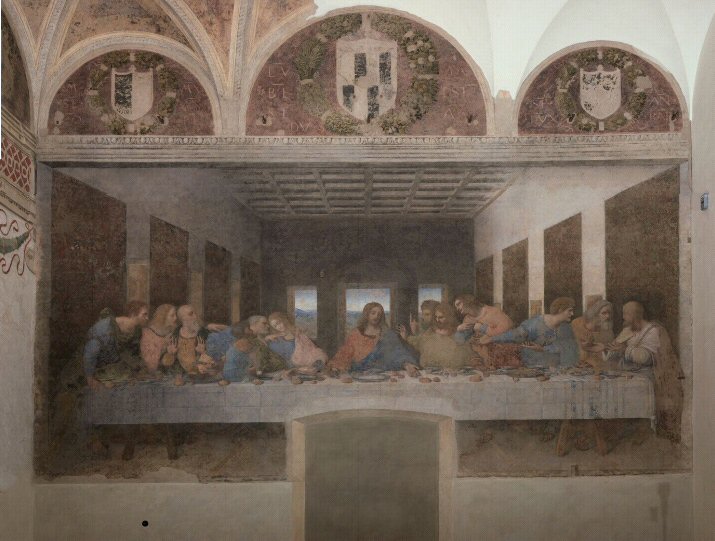
The Last Supper is a painting painted between 1496 to 1498 by Leonardo Da Vinci in the refectory of the Dominican convent of Santa Maria delle Grazie.
The painting was made using experimental pigments directly on the dry plaster wall and unlike frescos, where the pigments are mixed with the wet plaster, it has not stood the test of time well. Even before it was finished there were problems with the paint flaking from the wall and Leonardo had to repair it. Over the years it has crumbled, been vandalized bombed and restored. Today we are probably looking at very little of the original.
There are a number of points of interest:
Was it a 'Passover'?
Definitely not! The meal was set the day before 'Good Friday' - the day Jesus was crucified. The feast of the Passover began at sunset on that day so this meal was a day too early and, looking out the windows in the background, too early in the day. Also the picture shows Jesus and the disciples seated. The passover is traditionally eaten reclining. If you read your bible you will find:
Matthew 26.2 "You know that after two days the Passover is coming, and
the Son of man will be delivered up to be crucified." 26.3 Then the chief
priests and the elders of the people gathered in the palace of the high priest,
who was called Ca'iaphas, 26.4 and took counsel together in order to arrest
Jesus by stealth and kill him. 26.5 But they said, "Not during the feast,
lest there be a tumult among the people."
John 13.1 Now before the feast of the Passover, when Jesus knew that his hour
had come to depart out of this world to...
The food
The table shows leavened bread (yet another reason it could not be the Passover), fish, wine and some type of herb present. To me there also appears to be cheese present. There is no sign of lamb which would traditionally have been eaten at the passover.
The Cups/Glasses/Wine/Plates
There are twelve glasses shown to be present, each containing a red wine. It would be normal to drink wine with the meal - water was often contaminated. The glasses were odd however. Glass was popular with the Romans of the time but the conservative Jews would have drunk from goblets made from clay or wood. Only the wealthy would have drunk from metal goblets. The same is true of metal plates, several of which are shown. There's no pitcher or jug shown from which the glasses could have been refilled. There is a small, apparently empty, glass bottle, but this is too small to have contained the wine needed.
The instant depicted
This is supposed to be the moment when Jesus, in the words of John says "Truly, truly, I say to you, one of you will betray me". The picture shows the reaction of the disciples to this.
What's that bit centre bottom?
Around 1652, some unknown vandal decided to insert another door into the
refectory and apparently decided that the only logical spot for it
was smack in the middle of that wall where Leonardo had painted Christ's feet.
The only evidence we have of what the original painting looked like was an
oil paint copy made in the 16th centaury and now housed in Tongerlo Abbey ,
Antwerp
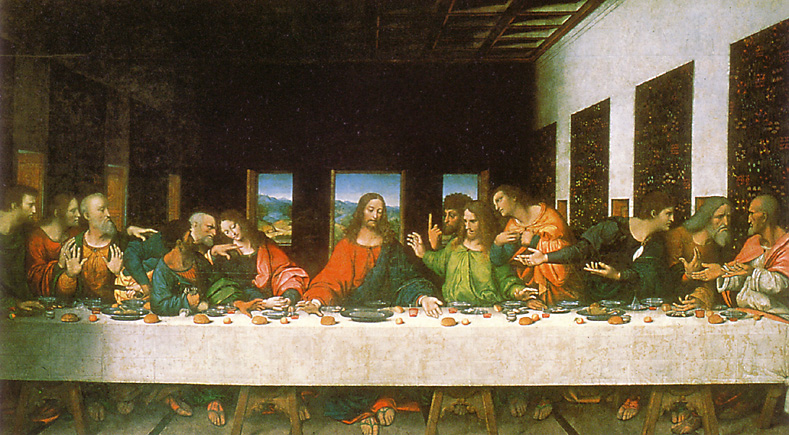
Move your pointer into or out of the picture to compare it with the
original
The Tongerlo Abbey copy, itself is believed to have been painted from an earlier copy by Giampietrino, a contemporary of Leonardo. His copy was made around 1520 and is oil paint on canvas. It was full size but at some point the canvas was cut down at the top and sides. it shows a great deal of detail and is believed to be a faithful reproduction of the original. 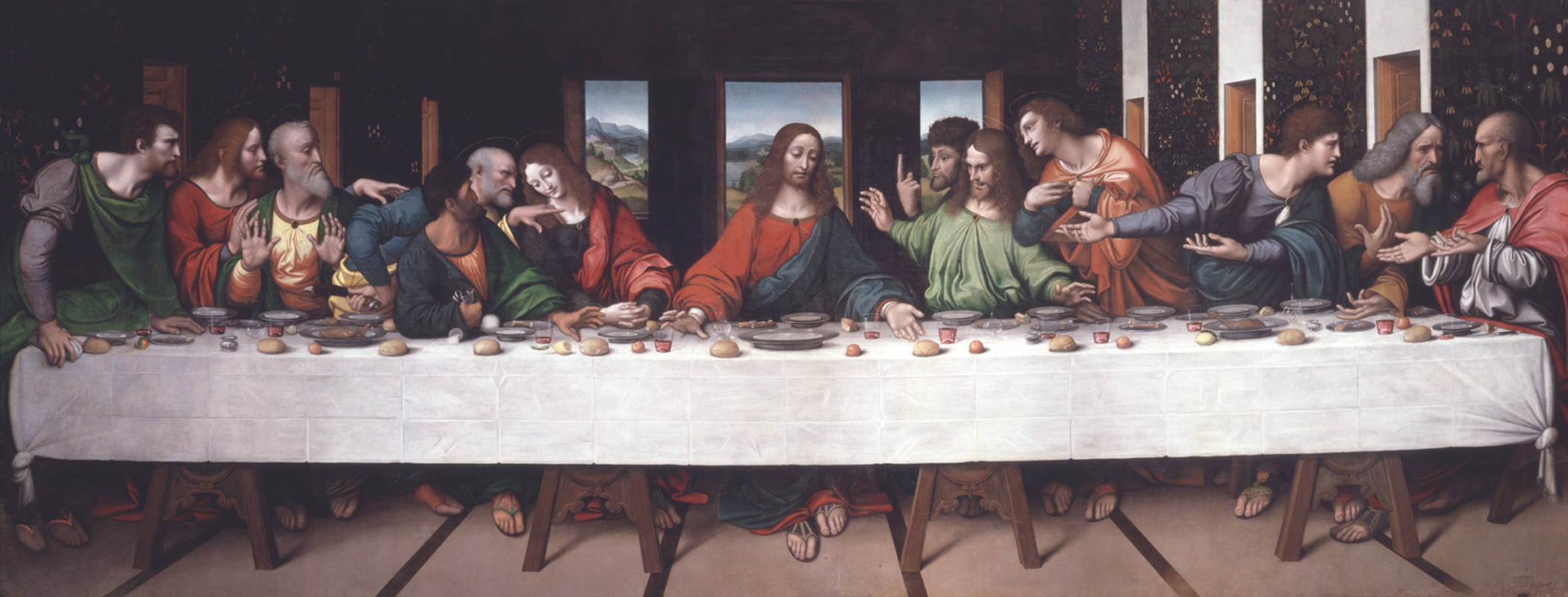
Just to complicate matters there's also a different version of the picture
in a tapestry shown below:
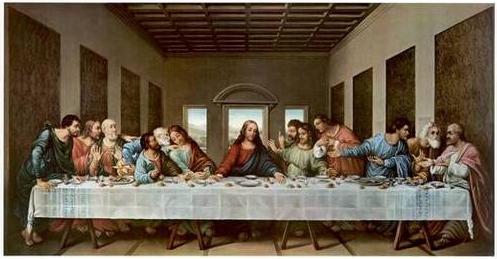
Move your pointer into or out of the picture to compare it with the original
The Knife
Due to it's poor condition there has been some argument about
the owner of the hand holding the knife (or, as some call it, - a dagger):
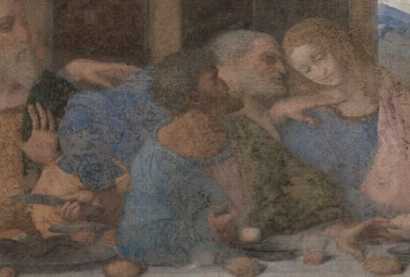
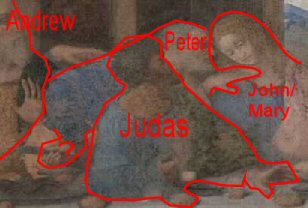
The theories are:
- The hand belongs to John/Mary (whoever you choose to believe they are). Peter is holding his/her wrist. Andrew, who sees this, is horrified at this.
- The hand belongs to a separate, obscured person, probably John, with Mary shown at the right.
- The hand holding the knife belongs to Peter - he has it twisted backwards away from Judas
-
.
Let's look at each theory in turn:
- Here's an image which has been doctored to remove Judas. Notice anything
odd?
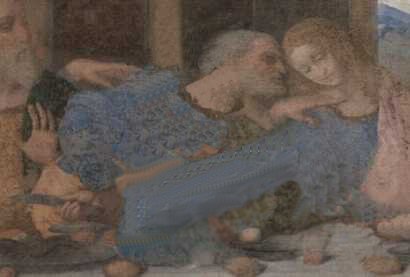
If that knife is being held by John/Mary then he/she has arms like a gorilla! Would Leonardo have made a mistake like this? There's also the evidence of John/Mary's fingers intertwined in front of him/her!
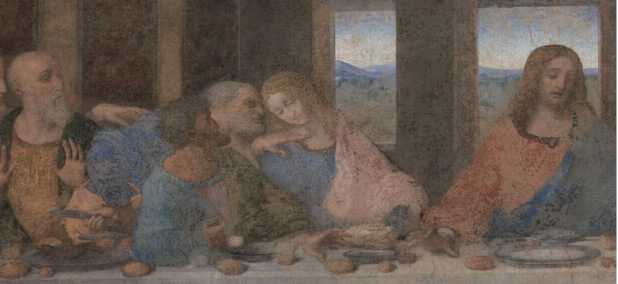
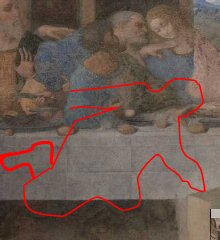 This
suggestion assumes that the feminine figure at the right in the image is
Mary Magdalene. In that case John, the youngest of the disciples is missing.
The idea is that the hand belongs to John who is obscured by Peter and Judas.
I find this very unlikely. If it were true - where exactly would John be?
This
suggestion assumes that the feminine figure at the right in the image is
Mary Magdalene. In that case John, the youngest of the disciples is missing.
The idea is that the hand belongs to John who is obscured by Peter and Judas.
I find this very unlikely. If it were true - where exactly would John be?
Maybe he dropped his glass?
 The
last suggestion is that Peter is holding the knife at a very odd angle. The
'copies' suggest that this is the case and so too does this sketch by Leonardo
- clearly that knife in the hand of Peter gave him some problems and he decided
to practice.
The
last suggestion is that Peter is holding the knife at a very odd angle. The
'copies' suggest that this is the case and so too does this sketch by Leonardo
- clearly that knife in the hand of Peter gave him some problems and he decided
to practice.
John or Mary Magdalene?
In the fictional book 'The Da Vinci Code', Daniel Brown has his character Teabing suggest that the figure seated to Jesus' right is not the disciple John but is instead Mary Magdalene. The theory, suggested several times in the past, is that Jesus married Mary and after the crucifixion she had a child by him.
I must admit that to my eye 'John' does look very effeminate. But is that enough evidence for the figure being Mary? We need to consider the following:
- Would the Church of the time have allowed this?
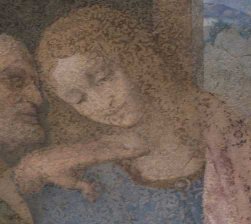
- It was 'normal' at the time for a young man, and John was the youngest of the disciples, to be portrayed as effeminate. Not only Leonardo did this.
- Leonardo is suspected to have been a homosexual.
- If 'John' is 'Mary' then where is John? Hiding under the table?
- Is that a necklace around 'John's' neck? If so - whatever happened to 'go, sell what you possess and give to the poor'. However no fewer than six others in the painting have a similar item, possibly a garment fastener.
- In 'The Da Vinci Code' Teabing refers to 'delicate folded hands, and the hint of a bosom'. Sorry - I don't see either! John's hands don't look feminine and to see a 'bosom' you need a great deal of imagination.
- Examine John/Mary's eybrows. In the time of Leonardo it was the fashion for women to shave them off. Try looking for eyebrows on the Mona Lisa. (although there is evidence that at one time Leonardo did paint them). It's also difficult to find eybrows on Philip and possibly James. Was that also true of young men at the time? I for one, simply don't know. Perhaps an 'expert' out there can help?
By far the simplest explanation is that Leonardo portrayed a young and beardless John as effeminate. The Church of the time appeared quite happy to accept this as such.
Who is where in the picture?

Image showing who is who in 'The Last Supper'.(Correction - James 'the younger' is accepted by the Catholic Church as the brother of Jesus; the other James was the brother of John the Baptist and therefore cousin to Jesus)
The grouping
Looking across the picture from left to right the disciples are shown in four groups of three:
- Bartholomew, James Minor and Andrew form a group of three. All are horrified, Andrew to the point of holding his hands up in a "let's calm down " gesture.
- Judas, Peter and John form the next group of three. Judas has his face in shadow and is clutching a small bag, presumably money. He was quite often portrayed with this in last supper paintings. He is also reaching for bread at the same time as Jesus is. Peter, in the fashion of the time, is shown clutching a knife and, with his hand on John's shoulder, is asking a feminine-looking John "Who does he say it is?". John leans toward him to hear what he says creating a V shape between himself and Jesus which has been interpreted by some as an indication of a marriage between 'Mary' and Jesus.
- Christ is very much the calm person alone in the midst of the debate.
- Thomas, James the Elder and Philip are next. 'Doubting' Thomas is pointing upward, maybe asking for one shred of evidence that this is so. His other hand is on the table between James and Philip as though seeking something solid. James the Elder looks stunned and seems to be watching Jesus' left hand. Philip seems to be asking 'Is it me?'.
- Matthew, Thaddeus and Simon comprise the last group of three figures. Matthew and Thaddeus seem to be asking Simon about Jesus' statement.
It was supposed to take place in the evening - after the sun had set. Leonardo
however, shows the outside in the three windows as being sunlit. He also shows
a third light source, apparently from the front left - exactly where the windows
and door are in the building. It seems he was trying to create the illusion
of a bigger building and suspected it would be used mostly during the day.
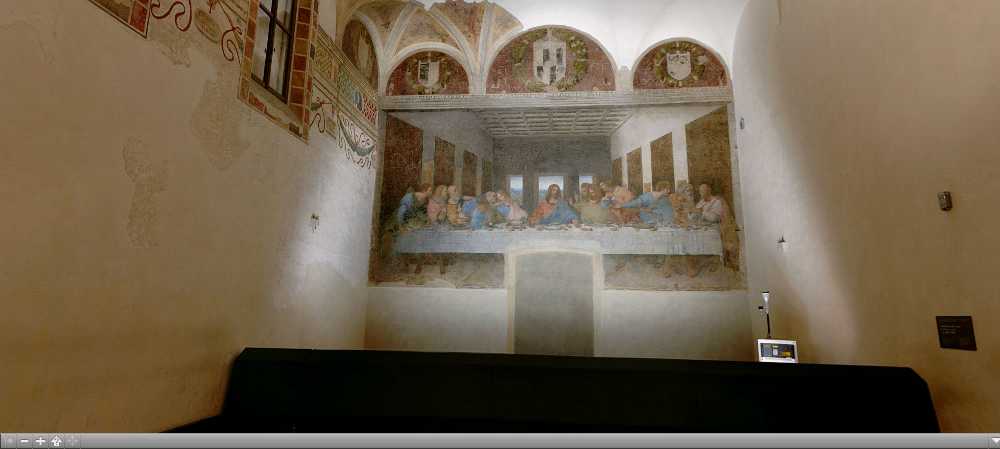
The end wall of the refectory of the Dominican convent of Santa Maria delle Grazie.
Views of some others
In the film 'The Da Vinci Code', the character Teabing shows that John/Mary can be moved and will fit exactly on Jesus' shoulder. I wondered if this was true for any others so played about with the picture in the same way:
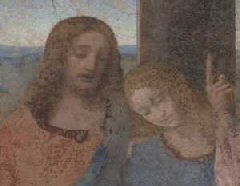 |
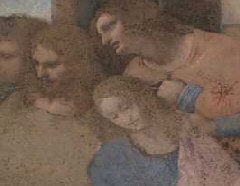 |
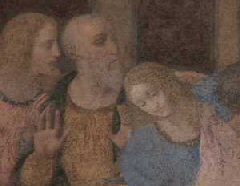 |
Jesus and 'Mary' |
James and 'Mary' |
Andrew and 'Mary' |
Seem it's not so remarkable after all Mr Teabing, in fact you can even almost make 'Mary' fit on Judas' shoulder!
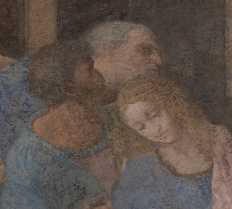 Teabing
also makes the claim that Peter
Teabing
also makes the claim that Peter 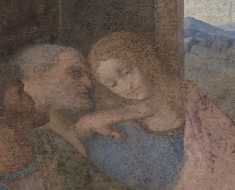 makes
a threatening gesture over 'Mary's' throat. Sorry - I don't see this and if
it were so then 'she' does not look the least concerned about this.
makes
a threatening gesture over 'Mary's' throat. Sorry - I don't see this and if
it were so then 'she' does not look the least concerned about this.
I've also seen some websites claiming that Judas is the only disciple leaning away from Jesus. They must be blind since on the left Andrew, Judas and John lean away and on the right Matthew and Thaddeus lean away.
Incidentally did you know that there are over 400,000 pages referring to this
painting of which 50,000 also refer to Daniel Brown's book 'The
Da Vinci Code'? 1750 entries also refer to an earlier book 'The
Templar Revelation: Secret Guardians of the True Identity of Christ'
by written by Lynn Picknett and Clive Prince in 1997. 750 refer to an even
earlier book Holy
Blood, Holy Grail by Michael Baigent, Richard Leigh and Henry Lincoln
(Even Daniel Brown refers to this book within his story and the character
'Leigh Teabing' seems to be a combination of 'Richard Leigh' and an anagram
of 'Baigent')
The Slavisa Pesci theory
Slavisa Pesci caused a huge increase in traffic to Last Supper websites (This page got 12 times it's normal traffic) when he announced that by superimposing a semi-transparent mirror image of The Last Supper over the original then new features would be revealed. The claim is that:
- A figure would be revealed holding a baby
- A chalice would appear in front of Christ
- A figure would appear resembling a Templar knight
Let's see if these claims are valid. In the picture below I've superimposed a mirror image of the original picture and aligned the images on Christ. The mirror image has been made 50% transparent. Here it is:

Not a great image is it! It requires a great deal of imagination to see a baby or a chalice. The Templar Knight is clearly Simon mixed with the arm of Bartholomew. I'm pretty sure Leonardo didn't intend for Christ to be portrayed as a cyclops either! Perhaps it's just that the image isn't aligned properly?
Here it is again with the windows and arches aligned:

Now this time although I can make out the Templar knight sat at each end of the table and a vague chalice in front of Jesus but the rest is just a mess! Maybe I'm using the wrong picture. After all the original has lost a lot of it's original colour.
Let's try the same thing using the painting from the Tongerlo Abbey:
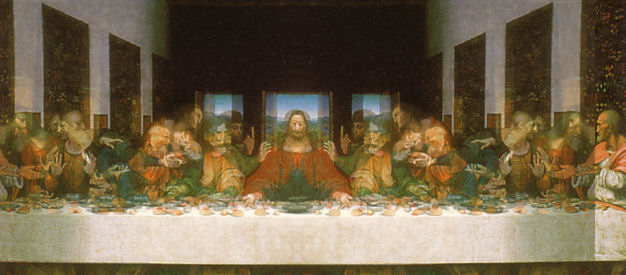
Now this time I can make out an even vaguer chalice in front of Christ and this time, centring the image on Christ's nose also aligns the archways. But the baby and the Templar knight? Can you see them? Moving the image to try different alignments does not improve it in any way and none of the three effects becomes more noticeable.
Finally I tried intensifying the colour, contrast and sharpness of the image
and experimented with different levels of transparency. Making the mirror image
70% transparent seemed to produce the best effect. The result is shown below
and you can compare it with the original image (also adjusted for colour, contrast
and sharpness) by moving your mouse over the image.
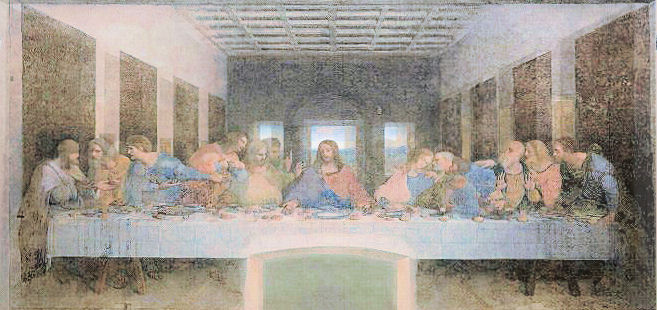
This time you can clearly make out the Templar knight on the left and Phillip
now holds a baby (Peter's head) but the chalice? It's not visible at these
settings.
Let's assume that this effect was deliberately planned by Leonardo. There's not much point in it unless it could be made visible in the time of Leonardo. The question is How would Leonardo have made this visible in his era? After all he didn't have Photoshop and a computer available to demonstrate it. Perhaps he made a copy of the painting on paper, oiled it to make it transparent and then looked through his reversed copy at the original? Seems a little unlikely to me!
Sorry Slavisa Pesci - without totally distorting the pictures in a way Leonardo would not have approved of, I don't think your theory holds water.
Finally there is now a site which allows you to study any area of the painting in close up, high definition. You'll need Flash, the site is in Italian and can take a while to load but it's worth a visit since it allows you to see more detail than a visit to the original
The Hand of the Mysteries
In his book 'The Lost Symbol
' Daniel Brown once again refers to Leonardo's Last Supper painting. This time he draws attention to Thomas's pointing finger which he suggests is representing 'The Hand of the Mysteries.' This is an ancient invitation to receive secret knowledge - protected wisdom known only to an elite few. If you were visiting this website, hoping to find evidence of this by finding tatoos on Tomas's pointing finger then you are going to be dissappointed. In actual fact the person to whom the 'hand' was presented was supposed to discover the secret by opening the hand to discover a message leading to these mysteries. As such Andrew's open right hand would be more representitive of 'the Hand of the Mysteries' so here, for those who are curious are close up pictures of both hands:
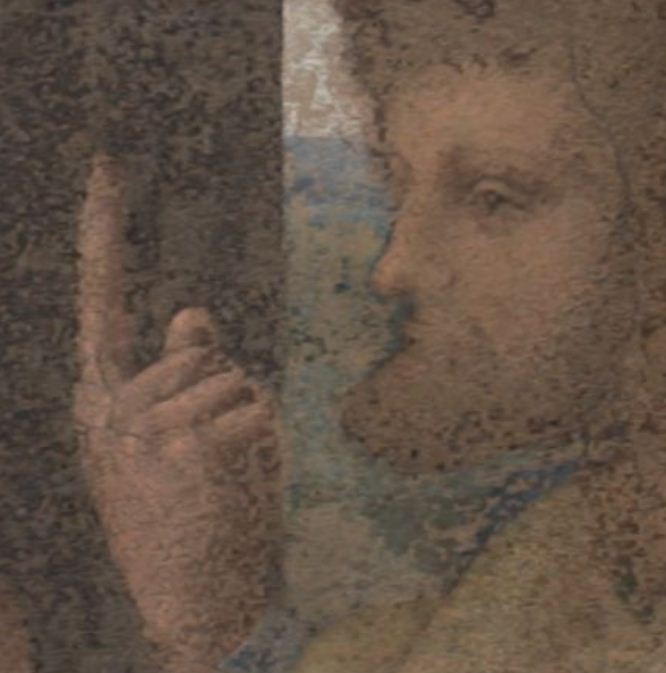
As you can see Thomas's hand is facing the wrong way for us to see any tatoo on the fingers - except the top of his thumb which doesn't to me look to have a crown on it.
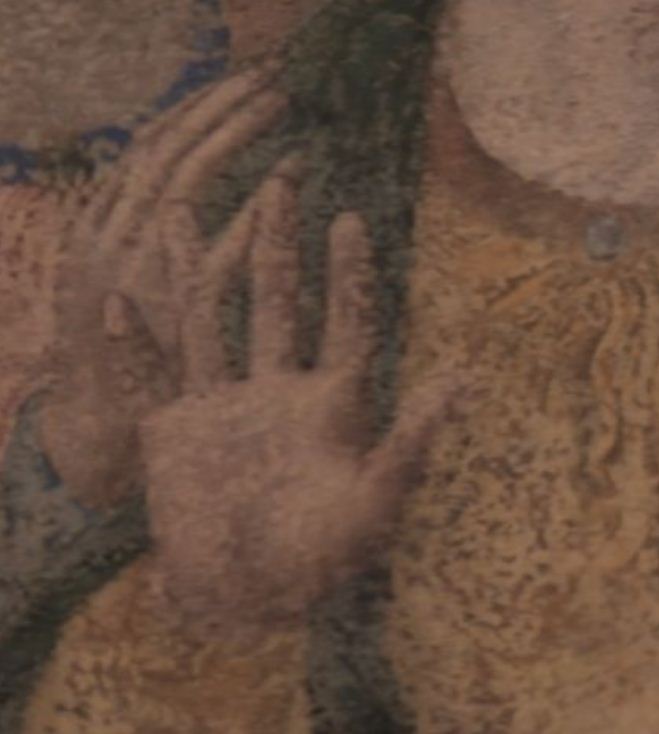
See any tatoos on Andrew's right hand? I don't think so!
Even allowing for the deteriation of the picture over the years, it's unlikely that the church of the time would have agreed to such tatoos being shown. There was after all that instruction in Leviticus 19:28 'Ye shall not make any cuttings in your flesh for the dead, nor print any marks upon you: I am the Lord' clearly an instruction that we should leave the human body the way that 'the Lord' created it.
I believe you will recognise that Daniel Brown has A Vested Interest in keeping information about the Last Supper formost in his readers mind and will return to the last Supper painting in future books. I would invite you to study the picture, and indeed the text here for more hidden meanings.
Want to comment on this page? Visit the JayDax Blog and leave it there. Failing that you can leave a comment below if you are a Facebook user.
If this post has proved useful to you would you do me a favour in return? Download a FREE copy of the book I co-author - a romantic technothriller called 'Immortality Gene'. Even if you don't read it it will help our ratings. You can get it at http://smarturl.it/avi and if you want to read it, you can use a phone, a tablet, a computer or even a Kindle.

